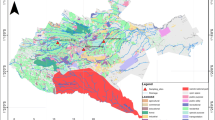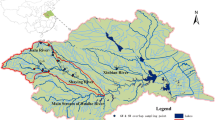Abstract
This study aimed to investigate the status and the environmental fate of 18 organochlorine pesticides (OCPs) in aquatic environment of an intensive agriculture area as well as popular tourism destination of Cameron Highlands, Malaysia. In the study area, eight stations were selected along two main rivers, namely, Bertam and Telom Rivers. Water and sediment samples were collected seven times from each station throughout 2011. The descriptive data analysis showed that lindane (γ–HCH) and endosulfan were predominant components. The total OCPs values were between <DL (detection limit) and 67.41 (mean of 7.55 ± 11.46) ng/L in the water samples. They were between 0.41 and 82.16 (mean of 21.33 ± 18.54) ng/g of dry weight in the sediment samples. Variations on the types of OCPs and the levels detected were noted with regards to spatial (land use) and seasons i.e. wet and dry seasons. Despite the low levels of the OCPs detected, detail analysis of HCH isomers and endosulfan metabolites indicate the possible reintroduction of the banned pesticides into the study environment.
Access provided by Autonomous University of Puebla. Download conference paper PDF
Similar content being viewed by others
Keywords
Highlights
-
Most of the OCP components in water and sediments were detected at low levels.
-
Evidence of reintroduction of banned pesticides.
-
Wet and dry seasons have major impact on the variation of OCPs.
Introduction
The Cameron Highlands river system, consists of three main rivers, Telom, Bertam and Lemoi, is an important source of water supply, irrigation for highland farming, recreation and hydroelectric power. Over the last decade, the rivers of Cameron Highlands were polluted, and many environmental problems emerged (Eisakhani and Malakahmad 2009). Therefore, improving the quality of water in rivers in Cameron Highlands is necessary to prevent further deterioration, thus enabling this area to continue as the main source of vegetable/flower production for Malaysia. This is very crucial since most developed area in Cameron Highlands was upstream area of the river. Since pesticides were intensively used by the highland farmers, it is imperative that the status of these compounds particularly the banned OCPs in the aquatic environment is studied.
Materials and Methods
Eight sampling sites along the Bertam and Telom Rivers were selected and a total of 112 sediment and water samples were collected. The sediment samples were collected with a Peterson grab sampler to depth of about 5 cm. Water samples were collected as grab samples straight from the rivers. Mixed organochlorine pesticide standards consisted of 18 OCPs was obtained from Supelco (Belle-Fonte, USA). Fresh working standard solutions containing a mixture of the mixed OCPs, surrogates (2, 4, 5, 6-tetrachloro-m-xylene & decachlorobiphenyl) and the internal standard component (pentachloronitrobenzene) were prepared by stepwise dilution of the stock solution with the range 1.95, 3.91, 7.81, 15.63, 31.25 and 62.5 μg/L.
Organic free water was prepared according to standard method (American Public Health Association 2005; USEPA 1995).All solvents used were pesticide grade. The anhydrous sodium sulfate was purified by heating it to 400 °C for 4 h. Florisil (PR Grade) was used for cleanup in an activated form (USEPA 2007). Disposable 6 mL SPE cartridges with 0.5 g sorbent-octadecyl bonded, end-capped silica UCT, ENVIROCLEAN were used to extract water samples. GC/MS analyses were performed with an Agilent 7890A gas chromatograph (GC) directly coupled to the mass spectrometer system (MS) of an Agilent 5975C inert MSD with a triple-axis detector to confirm the order of components. Quantitative analysis of samples was also carried out using Varian chromopack CP-3800 Gas Chromatograph. The instrument was equipped with a 63Ni electron capture detector and a 30 m × 0.32 mm i.d. (0.25 μm film thickness) HP-5 ms fused silica capillary column. The concentrations of the OCPs were not modified by the recovery ratios of the surrogates.
The sediment water content was determined by oven drying for 12 h at 105 °C. A series of mesh sieves ranging from 0.0125 to 64 mm were applied to determine the particle size of the sediment samples. 10.00 g of an air-dried grounded homogenized sediment sample mixed with 10.00 g of anhydrous sodium sulfate and spiked with 1 mL of 0.160 ppm surrogate solutions was extracted with 300 mL of n-hexane/acetone 50:50 for 6 h in a Soxhlet extractor. The extracted volume was reduced using a Rotovap evaporator to about 5 mL and then clean-up using Florisil column. The column was eluted three times with 65 mL of n-hexane, 45 mL of 70:30 n-hexane/dichloromethane and 55 mL of dichloromethane. The cleaned solution was concentrated using a Rotovapor-R-3000 evaporator. This solution was further concentrated to 2 mL with a stream of high purity nitrogen. 1 μL of the concentrated solution was spiked with exactly 1 μL at 100 ppm of internal standard before injection into the GC-ECD.
Results and Discussion
Spatial and Temporal Distribution of OCPs
The OCPs in water and sediment samples have a slightly different geographic property of being scattered over the area. The Bertam River has higher levels of OCPs, particularly in nearby rural areas, vegetable plantations, and tourist destinations, such as Taman Sedia, FAMA Office, and Parit Fall. In BOH Tea Plantation station, DDTs, HCHs, and endosulfans were also detected in water samples. Sediment samples from Blue Valley exhibited the highest values, followed by those collected from Taman Sedia, FAMA Office, Parit Fall, and BOH Tea Plantation stations. The spatial distribution of OCPs in water seems not to follow the expected pattern i.e. lower concentration at downstream station due to dilution. Many tributaries in the area, which flow into the main rivers, affect the level of OCPs in addition to the effect of rain or run-off from agriculture areas in the study area.
Figure 48.1 shows a box plot of the distribution of OCPs during the wet and dry seasons in 2011. Water and sediment samples from Bertam and Telom Rivers had higher values during the wet season in line with those of Zhou et al. (2006). Zhou et al. (2006) also stated that OCPs in Zhejiang Province (East China) were released from wet deposits or from soil being eroded into water because of heavy rains. In Cameron Highlands, the months of February, June, and July were considered as dry season (monthly average rainfall of 50–150 mm). The months of April, May, August, and November were considered as wet season (monthly average rainfall of 300–400 mm).
The release of OCPs can be associated with surface runoff from tea and vegetable plantations and with the exposure of soil to pesticides. Pesticide usage increased during the wet season because the pesticides were wash off more quickly. Mazlan and Mumford (2005) also pointed out that an increase in pest infestation during the wet season results in using higher amounts of pesticides. The relationships among rainfall, soil erosion, and released OCPs can be determined by comparing OCP grouped values (Fig. 48.2). The highest amounts of HCHs, DDTs, endosulfans, endrins, and heptachlors were detected during the wet season. These components appear to come from vegetable farms and rural pollution sources near the stations. Pesticides were also able to be transported easily during the wet season because the slope area. Rainfall pattern changes lead to changes in the effects of various contamination sources. The study area did not experience any month without rainfall. Thus, the effect of rainfall could not be ignored completely even during the dry season.
γ–HCH in water samples showed slight difference between two seasons, thus indicating the possibility of sediments as pollution sources because β-HCH comes from impurities of γ–HCH products. The OCPs in sediment samples showed no difference during the wet and dry seasons except for γ–HCH (p = 0.015), endosulfan I (p = 0.045), and endosulfan II (p = 0.014). Differences found for γ–HCH and endosulfans indicate the possibility of new inputs to sediments during the wet season. This data analysis result supports the outcome of the HCH isomer ratio, which shows the possibility of new inputs of lindane (γ–HCH).
Conclusion
The OCPs in water and sediment samples have a slightly different geographic property of being scattered over the area. The Bertam River higher levels of OCPs, particularly in nearby rural areas, vegetable plantations, and tourist destinations. In BOH Tea station, DDTs, HCHs, and endosulfans were detected in water samples. Sediment samples from Blue Valley exhibited the highest values, followed by those collected from Taman Sedia, Fama Office, Parit Fall, and BOH Tea stations. An independent-sample t test was conducted to compare OCPs for wet and dry seasons. Significant differences were noted in water samples than in sediment samples, which is higher in wet season than dry season. Spatial distribution of OCPs in the water did not follow the expected pattern since many tributaries in the area draining into the rivers.
References
American Public Health Association (2005) Standard methods for the examination of water and wastewater. APHA, Washington
Eisakhani M, Malakahmad A (2009) Water quality assessment of Bertam River and its tributaries in Cameron Highlands, Malaysia. World Appl Sci J 7:769–776
Mazlan N, Mumford J (2005) Insecticide use in cabbage pest management in the Cameron Highlands, Malaysia. Crop Prot 24:31–39
USEPA (1995) Method 525.2, determination of organic compounds in drinking water by liquid–solid extraction and capillary column gas chromatography/mass spectrometry. USEPA, OHIO
USEPA (2007) Method 3620c, Florisil Cleanup, USEPA
Zhou R, Zhu L, Yang K, Chen Y (2006) Distribution of organochlorine pesticides in surface water and sediments from Qiantang River, East China. J Hazard Mater 137:68–75
Acknowledgments
The authors thank the ALIR-UKM staffs and En Man Ghani for technical assistance in running the GC. Part of the project is financed by ALIR’s grant (DPP-2013-058) and UKM-OUP-FST-2013.
Author information
Authors and Affiliations
Corresponding author
Editor information
Editors and Affiliations
Rights and permissions
Copyright information
© 2014 Springer Science+Business Media Singapore
About this paper
Cite this paper
Abdullah, M.P., Saadati, N., Zakaria, Z. (2014). Organochlorine Pesticides (OCPs) in Aquatic Environment of Cameron Highlands, Malaysia. In: Aris, A., Tengku Ismail, T., Harun, R., Abdullah, A., Ishak, M. (eds) From Sources to Solution. Springer, Singapore. https://doi.org/10.1007/978-981-4560-70-2_48
Download citation
DOI: https://doi.org/10.1007/978-981-4560-70-2_48
Published:
Publisher Name: Springer, Singapore
Print ISBN: 978-981-4560-69-6
Online ISBN: 978-981-4560-70-2
eBook Packages: Earth and Environmental ScienceEarth and Environmental Science (R0)






